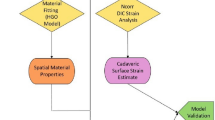Abstract
Purpose
No studies have used stress analysis with finite element analysis (FEA) to determine the causes of and mechanisms underlying rotator cuff tears. Therefore, we performed a biomechanical evaluation of the changes in stress distribution on the rotator cuff using three-dimensional (3-D) FEA.
Methods
The 3-D FEA model of shoulder joint allowed for abduction angles of 0°, 45° and 90° from the plane of the scapula and included the anatomical insertion points of the three major rotator cuff tendons and the middle fibres of the deltoid muscle. Stress distribution of the supraspinatus tendon on 3-D FEA was validated by a comparison with cadaveric and two-dimensional finite element model.
Results
The principal stress peaked in the region approximately 1 cm proximal to the insertion of the supraspinatus tendon. Furthermore, the stress on the joint side increased at the anterior edge of the supraspinatus tendon at abduction angles of 45° and 90°.
Conclusion
There are differences in stress changes between the joint side and bursal side of the supraspinatus tendon within the angles of abduction. The maximal tensile stress was observed on the articular side of the anterior edge of the supraspinatus tendon at 90° abduction. Our results indicate that the difference in tensile stress between the two layers results in delamination and causes partial-thickness tears.
Level of evidence
Decision analysis, Level II.




Similar content being viewed by others
References
Apreleva M, Parsons IM, Warner JJP, Fu FH, Woo SLY (2000) Experimental investigation of reaction forces at the glenohumeral joint during active abduction. J Should Elbow Surg 9:409–417
Brewer BJ (1979) Aging of the rotator cuff. Am J Sports Med 7:102–110
Buchler B, Ramaniraka NA, Rakotomanaa LR, Ianotii JP, Farron A (2002) A finite element model of the shoulder: application to the comparison of ormal and osteoartritic joint. Clin Biomech 17:630–639
Codman EA (1931) The pathology associated with rupture of the supraspinatus tendon. Ann Surg 93:348–359
Goto K, Tajima N, Chosa E, Totoribe K, Kuroki H, Arizumi Y, Takashi A (2002) Mechanical analysis of the lumbar vertebrae in a three-dimensional finite element method model in which intradiscal pressure in the nucleus pulposus was used to establish the model. J Orthop Sci 7:243–246
Inman VT, Saunders M, Abbott LC (1944) Observations on the function of the shoulder joint. J Bone Jt Surg Am 42:1–30
Itoi E, Berblund LJ, Grabowski JJ, Schultz FM, Growney ES, Morrey BF, An KN (2005) Tensile properties of the supraspinatus tendon. J Orthop Res 13:578–584
Karlsson D, Peterson B (1992) Towards a model for force predictions in the human shoulder. J Biomech 25:189–199
Keyes EL (1935) Anatomical observations on senile changes in the shoulder. J Bone Jt Surg 17-A:953–960
Lindblom K (1939) On pathogenesis of ruptures of the tendon aponeurosis of the shoulder joint. Acta Radial 20:563–577
Luo ZP, Hsh HC, Grabowski JJ, Morrey BF, An KN (1998) Mechanical environment associated with rotator cuff tears. J Should Elbow Surg 7:616–620
Nakajima T, Rokuuma N, Hamada K, Tomatsu T, Fukuda H (1994) Histologic and biomechanical characteristics of the supraspinatus tendon: reference to rotator cuff tearing. J Should Elbow Surg 3:79–87
Neer CS (1983) Impingement lesions. Clin Orthop 173:70–77
Parsons IM, Apreleva M, Fu FH, Woo SLY (2002) The effect of the rotator cuff tears on reaction forces at the glenohumeral joint. J Orthop Res 20:439–446
Reilly P, Amis AA, Wallace AL, Emery RJH (2003) Mechanical factors in the initiation and propagation of tears the rotator cuff. J Bone Jt Surg 4:559–594
Sano H, Wakabayashi I, Itoi E (2006) Stress distribution in the supraspinatus tendon with partial thickness tears. J Should Elbow Surg 15:100–105
Seki N, Itoi E, Shibuya Y, Wakabayashi I, Sano H, Sashi R (2008) Mechanical environment of the supraspinatus tendon three-dimensional finite element model analysis. J Orthop Sci 13:348–353
Terrier A, Reist A, Vogel A, Farron A (2007) Effect of supraspinatus deficiency on humerus translation and glenohumeral contact force during abduction. Clin Biomech 22:645–651
Tuite MJ, Turnbull JR, Orwin JF (1998) Anterior versus posterior and rim-rent rotator cuff tears. Skeletal Radiol 27:237–243
Van der Helm FCT (1994) A finite element musculoskeletal model of the shoulder mechanism. J Biomech 24:551–569
Wakabayashi I, Itoi E, Sano H, Shibuya Y, Sashi R, Minagawa H, Kobayashi M (2003) Mechanical environment of the supraspinatus tendon: a two-dimensional finite element model analysis. J Should Elbow Surg 12:612–617
Walch G, Boileau P, Noel E, Donell ST (1992) Impingement of the deep surface of the supraspinatus tendon on the posterosuperior glenoid rim: an arthroscopic study. J Should Elbow Surg 1:238–245
Acknowledgments
The authors thank the technicians at the Institute of Mechanical Systems Engineering and the Industrial Technology Center of Miyazaki for their valuable collaboration. This study was supported by a Grant-in-Aid from the Ministry of Education, Culture, Sports, Science and Technology of Japan. No financial remuneration related to the subject of this article was received by the authors or by any member of their families.
Author information
Authors and Affiliations
Corresponding author
Rights and permissions
About this article
Cite this article
Inoue, A., Chosa, E., Goto, K. et al. Nonlinear stress analysis of the supraspinatus tendon using three-dimensional finite element analysis. Knee Surg Sports Traumatol Arthrosc 21, 1151–1157 (2013). https://doi.org/10.1007/s00167-012-2008-4
Received:
Accepted:
Published:
Issue Date:
DOI: https://doi.org/10.1007/s00167-012-2008-4




